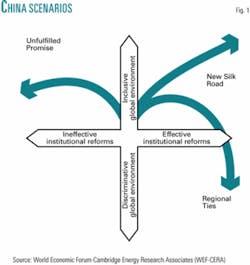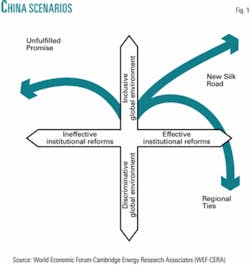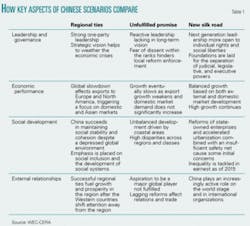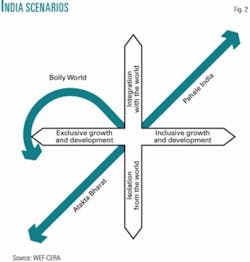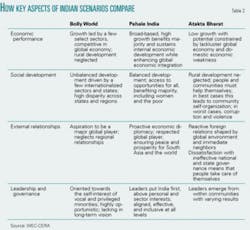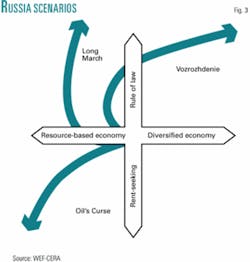Security study maps choices for China, India, and Russia
China, India, and Russia will be pivotal to a “new energy security paradigm” outlined in a recent study by the World Economic Forum (WEF) in partnership with Cambridge Energy Research Associates (CERA).
The roles of those countries “will weigh on both the supply and demand elements,”the study says in an introduction to analyses of all three.
The study notes that key elements of energy security-such as supply sources, demand centers, geopolitics, market structures, and institutions-have changed since the targeted oil embargo by Arab exporters in 1974. Arguing for consideration of those changes in modern analyses of energy security, it says new concerns have arisen, such as:
• Shifts between state ownership and regulation, on the one hand, and deregulated, commercially based structures, on the other. “Combined with continued globalization, there is a possibility that the pendulum may swing back toward greater state control for power markets as well as oil and gas markets if markets are perceived to be insufficiently reliable,” it says.
• The growing use by some governments of energy markets as tools of influence. The trend will have “spillover effects” in reactions of governments and corporations to any energy crisis.
• Increasingly vocal local communities concerned about the effects of new energy developments.
• Concerns about climate change. The concerns influence choices about energy sources as well as government policies.
• Closer linkage of the world economy and energy markets than was the case 30, or even 5, years ago. Hurricane disruption of Gulf of Mexico oil and gas supplies last year, for example, had effects in Europe, Latin America, the Middle East, Asia, and Africa. “Similarly, financial flows are closely linked, and any slowdown in one economy would put all economies at risk,” the study says.
Within this new and changing climate of energy security, China, India, and Russia will exert more influence than they have in the past.
For each country, the WEF-CERA study bases projects on three scenarios defined in terms of four core variables.
China’s outlook
For China, the WEF-CERA study highlights two central issues.
One of them is whether the country can implement internal reforms to further its development. The other is how its relationships with the rest of the world affect its development and “shape the global context.”
Among factors influencing these issues in the next 2 decades will be the intent of China’s leadership and the ability to ensure implementation of whatever decisions are made.
Also important will be choices of economic policy, including the degree of liberalization and openness.
Other factors weighing on China’s core issues will be the extent to which social stability can be maintained and popular expectations managed and the reaction of other global parties to China’s rise.
The study formulates China’s outlook within three named scenarios (Fig. 1):
• Regional Ties. In the Regional Ties scenario, global protectionism hinders trade. China increasingly turns to the rest of Asia for trade, investment, and support as it pursues reform and economic development.
In this scenario, the study says, “Chinese leadership and vision facilitate the forging of regional ties that help overcome historical enmities.”
• Unfulfilled Promise. A desire for economic development doesn’t lead to the necessary structural reforms in the Unfulfilled Promise scenario. Global economic integration continues but is tempered by security concerns. China struggles to implement tough reforms but has limited success, so economic, social, and ecological development suffer.
“The name reflects the general sentiment among the Chinese people that the promise made to them in terms of inclusive economic development has been largely unfulfilled,” the WEF-CERA study says.
• New Silk Road. The economic and cultural rise of China overcomes “substantial internal obstacles” in the New Silk Road scenario. The country achieves peaceful geopolitical integration and a “sizeable role in the exchange of goods, services, investments, and ideas.”
Success comes from strong and inclusive global economic growth stemming from trade integration and cross-border flows. China backs up the global trends with financial, legal, and administrative reforms and the emergence of a middle class and internal market.
A major conclusion of the WEF-CERA analysis: “The determination of the Chinese leadership to maintain the course of reform will be a decisive factor in the global future.”
At the same time, the study says, support of other global players and their welcome of China’s rise will “have a direct impact on how China emerges (Table 1).”
The study says, “Outsiders must appreciate the scale of the challenges faced by the government in Beijing,” and “those in China need to comprehend the sensitivities of outsiders to its rise.”
India’s change
Reforms of the 1980s and 1990s and the advance of globalization, helped by technological developments, have increased India’s significance in international markets, the WEF-CERA study notes. Some analysts expect India to achieve economic success similar to that of China.
Sustaining India’s progress, the study says, will be favorable demographics; a large pool of low-cost, skilled labor; entrepreneurial indigenous companies; continuing economic reforms and global integration; a stable political regime and democracy; and a record of high, sustained growth rates.
Important questions facing India are whether the country can engage the whole nation in its quest for sustained security and prosperity and how India’s relationship with the world will affect the national agenda.
India’s scenarios (Fig. 2):
• Bolly World. Assigned a name used for India’s film industry, the Bolly World scenario leads to economic reversal as initial economic success becomes unsustainable and demographic pressures rise.
In this scenario, the study says, “India’s leaders are so dazzled by the immediate gains to be made in international markets that they fail to implement much-needed domestic reforms.”
• Pahale India. “Pahale India” means “India First.” In this scenario, a broadly shared vision for India “aligns national aspirations and creates common goals.” Development of a broad-based economy gives the country enough internal strength to support its ambitions to become “a major world player.”
As Indians from across the country put the needs of their community and country first, India becomes a global economic leader as well as a source of inspiration elsewhere in the world.
• Atakta Bharat. If the international environment doesn’t support its ambitions, India faces a scenario the WEF-CERA study calls Atakta Bharat, meaning “India Getting Stuck.” In this scenario, the global economy slows and offers few benefits to India, within which development is slight and uneven.
The scenario reflects a lack of unified action and absence of effective leadership, creating “a continuous and cumulative source of problems” for the country (Table 2).
“The challenges that India faces and the actions that India needs to take to secure its future seem well known,” the study says. “The question arises: Can its leaders and people put this understanding into practice and do what is needed as a nation in collaboration with the international community?”
Russia’s opportunity
Strong growth in gross domestic product in the past 5 years has enabled Russian President Vladimir Putin to introduce reforms, including a flat income tax, a new land and legal code, and legislation on currency liberalization.
The study says Putin’s “most significant achievement” has been balancing the government budget and slashing borrowing from the International Monetary Fund.
While the recent growth has reversed the 30% gross domestic product decrease of 1992-98 and created large current-account surpluses and reserves, it doesn’t ensure sustained economic development.
Vital questions for Russia are whether the country develops legitimate and effective governance based on the rule of law and how effectively it develops a broad-based economy given its extensive energy resources.
Important to how those questions are answered, the study says, will be the nature, openness, and leadership qualities of the Russian elite and the country’s interest in and ability to impose the rule of law.
Another important factor will be the choice of economic policy and the extent of freedom granted to private capital in energy and nonenergy industries.
The challenge of maintaining social cohesion in view of the country’s geographic breadth and its serious demographic problems also will be crucial, as will Russia’s relations with the rest of the world.
“Today, Russia’s economy is booming because of high oil prices,” the study points out. “But the benefits of this increased economic prosperity are shared only among the elite, while the income gap between regions continues to grow.”
Russia’s scenarios (Fig.3):
• Long March. In the Long March scenario, Russia continues to emphasize its natural resources to the detriment of the full development of other economic sectors. The transition to governance based on the rule of law is gradual.
Russia achieves relative prosperity in this scenario, “but a far less benign future is also possible,” the study says.
• Oil’s Curse. “A political class bent on its own enrichment is in charge” under the Oil’s Curse scenario. The results are slow growth, poor levels of investment in infrastructure, capital flight, increased corruption, and a decline in the competitiveness of Russian industries.
• Vozrozhdenie. Meaning “Renaissance,” the Vozrozhdenie scenario represents a “radical departure” from the past leading to “real economic and social progress.”
The scenario includes gradual but wide-reaching governance reforms coupled with market reforms leading to strong GDP growth, an increase in real income, and general improvement in the quality of life for the general population.
“The coming years could well be a crossroads for Russia,” the study says (Table 3). “Will the tendency to authoritarianism persist, or will there be a determined effort to promote more-open democratic structures? Will the Russian economy be narrowly based on natural resources or much more broadly based? A large part of the answer lies in the hands of the leaders and the people of the country itself.”
The study says Russian energy and determination, evident throughout history, will help the country solve its problems. And it says other countries should help, “notably to open doors and provide examples that could help Russia move forward.”
Security implications
The emergence of China, India, and Russia bears on questions raised in the study about the implications of the new concern for energy security.
The study asks, for example, whether new international institutions will be needed to complement the International Energy Agency, which was formed around an international scheme for sharing oil during supply emergencies.
“How can other countries-China, India, and Russia-be integrated into the system?” it asks.
Questions also loom about the adequacy of traditional market signals relative to the needs to increase energy supply and to reduce demand or slow its growth.
And along with institutional and market questions come the challenges of globalization, with its emphasis on integration of multiple systems. Integration not only reduces inefficiencies, the study notes, but also creates new vulnerabilities.
“How can societies take advantage of integration while also protecting against its risks?” it asks.
And more generally: “What are the implications of a new energy security paradigm? Are new structures needed? Or would modifications to our current approach that focuses on oil disruptions in the Middle East suffice?”
